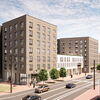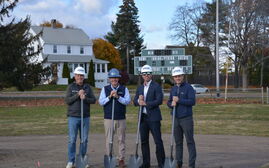Processing Your Payment
Please do not leave this page until complete. This can take a few moments.
- News
-
Editions
View Digital Editions
Biweekly Issues
- December 15, 2025
- December 1, 2025
- Nov. 17, 2025
- November 03, 2025
- October 20, 2025
- October 6, 2025
- + More
Special Editions
- Lists
- Viewpoints
-
Our Events
Event Info
Award Honorees
- Calendar
- Biz Marketplace
10 takeaways from the MEREDA Real Estate Forecast Conference
 Photo / Peter Van Allen
MEREDA's 2023 Annual Real Estate Forecast Conference, held Jan. 26 at Cross Insurance Center.
Photo / Peter Van Allen
MEREDA's 2023 Annual Real Estate Forecast Conference, held Jan. 26 at Cross Insurance Center.
The Maine Real Estate Development Association’s annual Real Estate Forecast Conference always presents a wealth of information.
This year’s conference, held Jan. 26 at Cross Insurance Center, offered a new wrinkle.
The real estate industry is dealing with higher interest rates, continued volatility in construction and materials costs, lingering supply chain issues and the threat of recession. The need for housing of all kinds, but especially affordable housing, continues to be a challenge.
Yet through all of this uncertainty, there were 10 trends that seemed noteworthy:
- Buyers are still looking for move-in-ready homes. The residential market, coming off two red hot years, peaked in the summer when the median sale price topped out at $360,000 in June. The median sale price is still at $335,000 — remember, it was $200,000 in 2017, so it’s been a dramatic increase. The past two years were characterized by people moving from out of state — often with cash in, so there were bidding wars and cash offers. This year, Dava Davin from Portside Real Estate says there will still be multiple bids on “cream puff” offerings, those homes that are in move-in condition. Less desirable places are sitting on the market.
- Multifamily housing is in demand. In Portland, two major projects underway — Redfern's Federal Street apartment building, with 190 units, and Port Property's West Bayside project with 171 units, were approved before the Green New Deal. That and other regulations are expected to have a long-term effect on Portland, with development dollars going to Biddeford-Saco and Lewiston-Auburn, among other places, according to Brit Vitalius of Vitalius Real Estate.
- No slowdown in construction. This is more anecdotal, based on what I heard walking around the showcase, but many construction firms are booked up well into 2024. Some projects were approved before interest rates went up, but others are chugging ahead anyway. So we’ll keep an eye on the horizon beyond 2024.
- Industrial properties are still in high demand. With very low vacancy rates, especially in southern Maine, industrial property is driving rates comparable to office leasing rates, according to Justin Lamontagne of the Dunham Group. Cannabis companies are still taking space. Supply chain challenges have convinced more companies to keep a larger inventory of products on hand. There’s even talk of converting some office space to light industrial use.
- Yes in my backyard. In a direct contrast to some towns and cities in Maine that are shunning development, some other cities are saying yes, according to Frank Carr of Maine Realty Advisors. Lewiston, Auburn, Augusta and Waterville are all hosting development of office space, retail and multifamily and single-family housing, among other things.
- Downtown Bangor is coming alive. A strong office market, new apartments and a core of restaurants and retail are driving a resurgence of the downtown, said David Hughes of Epstein Commercial Real Estate. “People enjoy living and working downtown,” he told the MEREDA crowd.
- Policy changes are in the air. Portland’s adoption of inclusionary zoning rules, which require a percentage of affordable housing with each development, may become a trend statewide. Elizabeth Frazier, MEREDA’s public policy counsel and an attorney with Pierce Atwood, predicts that state and local lawmakers will look for a “balancing act” on policies around affordable housing and inclusionary zoning.
- Retail is “not dead.” Of Greater Portland’s 6.6 million square feet of retail space, just 4.23% is vacant, according to Peter Harrington of Malone Commercial Brokers. Rumors of retail’s demise are greatly exaggerated. “I’m here to tell you,” Harrington said, “that’s simply not true.” He cited Westbrook’s Rock Row as a success story, with Market Basket, REI, Chick fil-A, Chase Bank and other retailers.
- "Steady" demand for office space in southern Maine. Nate Stevens of the Boulos Co. says we can expect a “clearer market outlook, more time to look at the post-pandemic market,” with steady demand.
- A wider range of homes needed. Greg Payne, a senior advisor on housing in the Mills administration, talked about the large gap between the supply of housing units in Maine and the demand. He emphasized the need for zoning that allows for development of multifamily homes and accessory dwelling units. One side note that came out of Dava Davin’s residential report was the increased demand for mobile homes. It’s not surprising, given that the single-family home market is so tight and the prices are high. With an abundance of land in many parts of Maine, it makes sense.
Mainebiz web partners
Related Content

The Giving Guide
The Giving Guide helps nonprofits have the opportunity to showcase and differentiate their organizations so that businesses better understand how they can contribute to a nonprofit’s mission and work.
Learn More
Work for ME
Work for ME is a workforce development tool to help Maine’s employers target Maine’s emerging workforce. Work for ME highlights each industry, its impact on Maine’s economy, the jobs available to entry-level workers, the training and education needed to get a career started.
Learn More
Groundbreaking Maine
Whether you’re a developer, financer, architect, or industry enthusiast, Groundbreaking Maine is crafted to be your go-to source for valuable insights in Maine’s real estate and construction community.
Learn more-
The Giving Guide
The Giving Guide helps nonprofits have the opportunity to showcase and differentiate their organizations so that businesses better understand how they can contribute to a nonprofit’s mission and work.
-
Work for ME
Work for ME is a workforce development tool to help Maine’s employers target Maine’s emerging workforce. Work for ME highlights each industry, its impact on Maine’s economy, the jobs available to entry-level workers, the training and education needed to get a career started.
-
Groundbreaking Maine
Whether you’re a developer, financer, architect, or industry enthusiast, Groundbreaking Maine is crafted to be your go-to source for valuable insights in Maine’s real estate and construction community.
ABOUT
NEW ENGLAND BUSINESS MEDIA SITES
No articles left
Get access now
In order to use this feature, we need some information from you. You can also login or register for a free account.
By clicking submit you are agreeing to our cookie usage and Privacy Policy
Already have an account? Login
Already have an account? Login
Want to create an account? Register
Get access now
In order to use this feature, we need some information from you. You can also login or register for a free account.
By clicking submit you are agreeing to our cookie usage and Privacy Policy
Already have an account? Login
Already have an account? Login
Want to create an account? Register











0 Comments